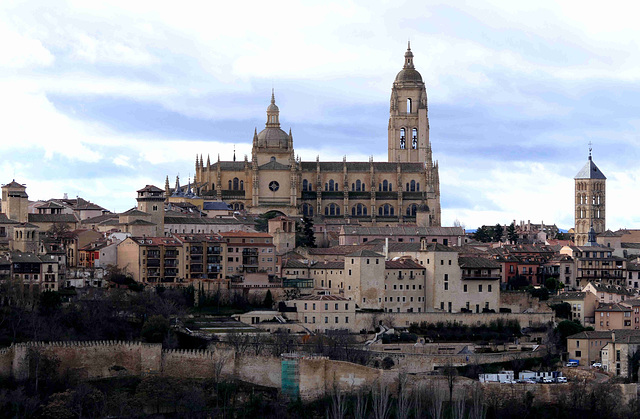Segovia - La Vera Cruz
Guadalajara - Iglesia de los Remedios
Carabias - Iglesia de San Salvador
Sigüenza - Catedral de Santa María
Baeza - Iglesia de la Santa Cruz
Jaén - Catedral de la Asunción
Cáceres - San Francisco Javier
Lisboa - Sé de Lisboa
Alcobaça - Mosteiro de Alcobaça
Bosham - Holy Trinity Church
Salisbury - Cathedral
Eastleach - St Michael and St Martin's Church
Malmesbury - Abbey
Langford - St Matthew's Church
Shrewsbury - Abbey
Grimsby - Grimsby Minster
Riccall - St Mary
Ledsham - All Saints
Cartmel - Priory
Carlisle - Cathedral
Hexham - Abbey
Cartuja de Jerez de la Frontera
Huelva - Nuestra Señora de la Concepción
Zamora - Catedral de Zamora
Zamora - Catedral de Zamora
Zamora - Santa María Magdalena
Zamora - San Cipriano
Venta de Baños - San Juan de Baños
Palencia - San Miguel
León - Catedral de León
Carrión de los Condes - Iglesia de Santiago
Miñón de Santibáñez - San Pedro
Burgo de Osma - Catedral de Santa María de la Asun…
Almazán - Ermita de Jesus
Bourges - Cathedral
Hannoversch Münden - St. Blasius
Naumburg - Dom
Leipzig - Nikolaikirche
Grimma - Frauenkirche
Freiberg - Dom St. Marien
Leipzig - Nikolaikirche
Tangermünde - St. Stephan
Havelberg - Dom Sankt Marien
Wust - Dorfkirche
Jerichow - Stadtkirche
Location
Lat, Lng:
You can copy the above to your favourite mapping app.
Address: unknown
You can copy the above to your favourite mapping app.
Address: unknown
See also...
Keywords
Authorizations, license
-
Visible by: Everyone -
All rights reserved
-
89 visits
Segovia - Catedral de Segovia


A Celtic castle existed here, from which resistance against the Romans originated. The city was nevertheless taken. Afterward, it began to be built as a Roman city and became an important Roman military base.
In the second half of the 5th century, Segovia became part of the Visigoth Empire. From the 8th to the 11th centuries, Segovia was under Moorish possession. In 1085 Alfonso VI conquered the city. From the 13th to the 15th century it was a royal residence.
The predecessor of the Catedral de Segovia (aka "Santa Iglesia Catedral de Nuestra Señora de la Asunción y de San Frutos de Segovia" was a church that began around 1140 when Segovia was repopulated under Alfonso VII. This church was destroyed during a popular uprising in Castile in 1520. In 1525 the cathedral chapter decided to build a new building. The foundation stone was laid in 1525. In 1558 the building was completed up to the transept and was consecrated as a cathedral. It was erected in a late Gothic style, outdated elsewhere in Europe.
In 1614 the large spire was destroyed by lightning. It was made of mahogany imported from America and covered with fire-gilded lead. The cathedral ceilings were also damaged by the fire. During a restoration around 1620, the tower was given its current shape, reduced by 12 m in height.
The cathedral was finally consecrated in 1768. It is 105 m long and 50 m wide. The central nave is 33 m high. The tower measures 88 m.
In the second half of the 5th century, Segovia became part of the Visigoth Empire. From the 8th to the 11th centuries, Segovia was under Moorish possession. In 1085 Alfonso VI conquered the city. From the 13th to the 15th century it was a royal residence.
The predecessor of the Catedral de Segovia (aka "Santa Iglesia Catedral de Nuestra Señora de la Asunción y de San Frutos de Segovia" was a church that began around 1140 when Segovia was repopulated under Alfonso VII. This church was destroyed during a popular uprising in Castile in 1520. In 1525 the cathedral chapter decided to build a new building. The foundation stone was laid in 1525. In 1558 the building was completed up to the transept and was consecrated as a cathedral. It was erected in a late Gothic style, outdated elsewhere in Europe.
In 1614 the large spire was destroyed by lightning. It was made of mahogany imported from America and covered with fire-gilded lead. The cathedral ceilings were also damaged by the fire. During a restoration around 1620, the tower was given its current shape, reduced by 12 m in height.
The cathedral was finally consecrated in 1768. It is 105 m long and 50 m wide. The central nave is 33 m high. The tower measures 88 m.
kiiti, buonacoppi, Paolo Tanino, appo-fam and 2 other people have particularly liked this photo
- Keyboard shortcuts:
Jump to top
RSS feed- Latest comments - Subscribe to the comment feeds of this photo
- ipernity © 2007-2025
- Help & Contact
|
Club news
|
About ipernity
|
History |
ipernity Club & Prices |
Guide of good conduct
Donate | Group guidelines | Privacy policy | Terms of use | Statutes | In memoria -
Facebook
Twitter

Sign-in to write a comment.